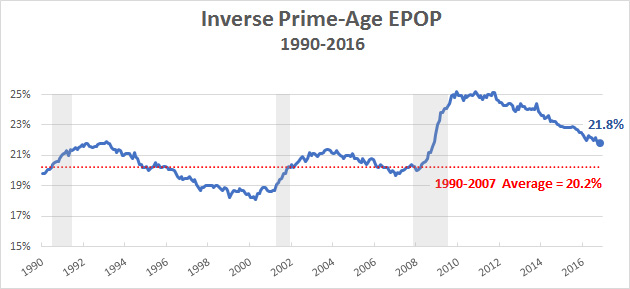Donald Trump thinks the official unemployment rate is “fiction,” so Jordan Weissmann suggests we judge him by a different metric. Instead of a complicated measure that tries to divine whether someone “wants” to work, or whether they “want” full-time work but can’t get it, or any of that nonsense, let’s use a simpler measure for this new, simpler era:
The BLS even produces a data point that Trump himself might like: The employment-to-population ratio for adults between the ages of 25 and 54—or “prime-age EPOP.”…It gives us a raw look at the employment rate, without any fancy caveats about who is and isn’t part of the labor force. And because it only tracks workers 25 to 54, it isn’t really distorted by the wave of retiring boomers or growing college attendance. It’s a simple snapshot of the portion of the population we most need to worry about….Best of all, from Trump’s perspective at least, prime-age EPOP has plenty of room for improvement….If Trump wants to argue that Obama left him an economy that was still hurting, this is one stat that will easily help make the case.
Fine. But we don’t really want to know how many people are working, we want to know how many people aren’t working. So here’s the inverse prime-age EPOP, since 1990:

IPA-EPOP1 fell steadily during the postwar period as more and more women left the (unpaid) household workforce and entered the (paid) market workforce, but it’s been relatively stable since 1990. That means we can think of the period from 1990 until the start of the Great Recession as sort of a baseline for normal. The average during this period was 20.2 percent, and right now we’re still 1.6 percentage points away from that. As Weissmann says, this gives Trump some room to show improvement.
Now, naysayers are going to complain that this doesn’t really make sense. After all, this number includes lots of people who don’t want to work, mostly stay-at-home mothers and fathers. Shouldn’t we take them out of this calculation? Sure, we should, but then we’re back to that whole tedious discussion of who’s in the labor force and who’s just given up and all that stuff. We want simple: working or not working, end of story. And in fairness, when the economy is hot, wages go up and more stay-at-home parents are drawn back into the workforce. That makes this an OK measure of economic hotness.
So there you have it. Trump’s starting point is an IPA-EPOP of 21.8 percent. In four years we’ll see if he’s managed to bring that down.
1Rolls right off the tongue, doesn’t it?













